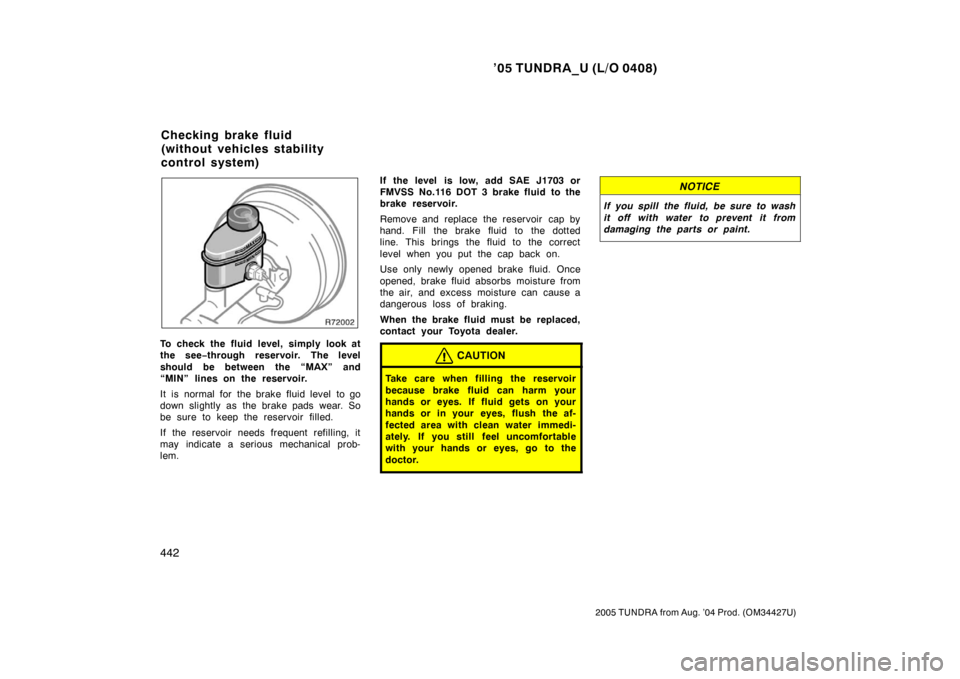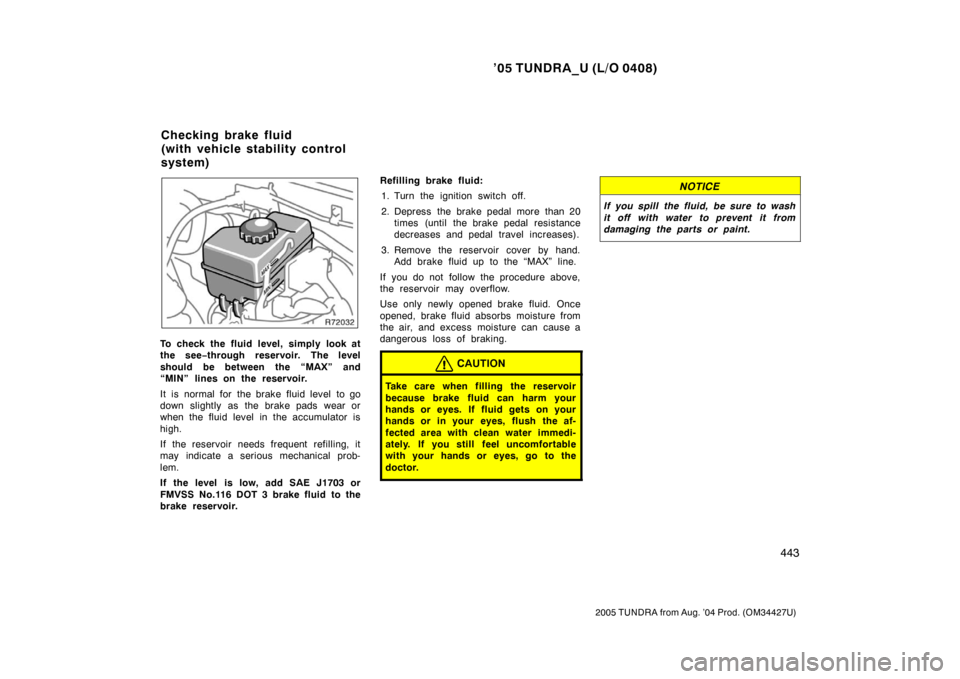Page 365 of 506

’05 TUNDRA_U (L/O 0408)
354
2005 TUNDRA from Aug. ’04 Prod. (OM34427U)
The brake pad wear limit indicators on
your disc brakes give a warning noise
when the brake pads are worn to where
replacement is required.
If you hear a squealing or scraping noise
while driving, have the brake pads
checked and replaced by your Toyota
dealer as soon as possible. Expensive ro-
tor damage can result if the pads are not
replaced when necessary.The rear step bumper is for rear end
protection and easier step− up loading.
CAUTION
�Do not allow more than one person
to get on the rear step bumper at
a time. It is designed for only one
person.
�Never drive the vehicle with anyone
on the rear step bumper.
The side step is for easier step −up
loading.
CAUTION
For models equipped with a StepSide
bed:
�Do not allow more than one person
to get on the side step. Do not
exceed the maximum weight limit of
136 kg (300 lb.) on the side step.
�Never drive the vehicle with anyone
on the side steps.
�Do not stand on the side steps
while the vehicle is moving.
Brake pad wear limit
indicators Rear step bumper StepSide bed
Page 453 of 506

’05 TUNDRA_U (L/O 0408)
442
2005 TUNDRA from Aug. ’04 Prod. (OM34427U)
To check the fluid level, simply look at
the see −through reservoir. The level
should be between the “MAX” and
“MIN” lines on the reservoir.
It is normal for the brake fluid level to go
down slightly as the brake pads wear. So
be sure to keep the reservoir filled.
If the reservoir needs frequent refilling, it
may indicate a serious mechanical prob-
lem. If the level is low, add SAE J1703 or
FMVSS No.116 DOT 3 brake fluid to the
brake reservoir.
Remove and replace the reservoir cap by
hand. Fill the brake fluid to the dotted
line. This brings the fluid to the correct
level when you put the cap back on.
Use only newly opened brake fluid. Once
opened, brake fluid absorbs moisture from
the air, and excess moisture can cause a
dangerous loss of braking.
When the brake fluid must be replaced,
contact your Toyota dealer.
CAUTION
Take care when filling the reservoir
because brake fluid can harm your
hands or eyes. If fluid gets on your
hands or in your eyes, flush the af-
fected area with clean water immedi-
ately. If you still feel uncomfortable
with your hands or eyes, go to the
doctor.
NOTICE
If you spill the fluid, be sure to wash
it off with water to prevent it from
damaging the parts or paint.
Checking brake fluid
(without vehicl
es stability
control system)
Page 454 of 506

’05 TUNDRA_U (L/O 0408)
443
2005 TUNDRA from Aug. ’04 Prod. (OM34427U)
To check the fluid level, simply look at
the see −through reservoir. The level
should be between the “MAX” and
“MIN” lines on the reservoir.
It is normal for the brake fluid level to go
down slightly as the brake pads wear or
when the fluid level in the accumulator is
high.
If the reservoir needs frequent refilling, it
may indicate a serious mechanical prob-
lem.
If the level is low, add SAE J1703 or
FMVSS No.116 DOT 3 brake fluid to the
brake reservoir. Refilling brake fluid:
1. Turn the ignition switch off.
2. Depress the brake pedal more than 20 times (until the brake pedal resistance
decreases and pedal travel increases).
3. Remove the reservoir cover by hand. Add brake fluid up to the “MAX” line.
If you do not follow the procedure above,
the reservoir may overflow.
Use only newly opened brake fluid. Once
opened, brake fluid absorbs moisture from
the air, and excess moisture can cause a
dangerous loss of braking.
CAUTION
Take care when filling the reservoir
because brake fluid can harm your
hands or eyes. If fluid gets on your
hands or in your eyes, flush the af-
fected area with clean water immedi-
ately. If you still feel uncomfortable
with your hands or eyes, go to the
doctor.
NOTICE
If you spill the fluid, be sure to wash
it off with water to prevent it from
damaging the parts or paint.
Checking brake fluid
(with vehicle stability control
system)